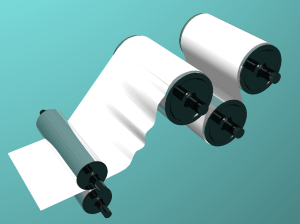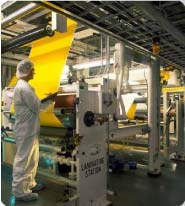The misalignment of your coating/laminating equipment can cause excessive waste and downtime, poor product quality and a decrease in overall efficiency – all of which can lead to dissatisfied customers.
So, how can you be sure that misalignment is the problem?
An alignment inspection of your production line is your best course of action. However, if you begin seeing any of the following symptoms, chances are there is misalignment in one or more areas of your machine:
- Excessive movement of guide rolls – Guide rolls are designed to compensate for inconsistencies in the substrate. If the product begins to run consistently to one side of its travel range, there is a high probability of misalignment in rolls upstream or downstream of the guide.
- Appearance of wrinkles – If wrinkles begin to appear in any area of the machine, it could be misalignment in that area OR areas prior to or after that section.
- Uneven Cross-Machine Web Tension – If you begin to see uneven cross-machine readings from your load cells, there could be misalignment in the rollers through-out the machine, and the cumulative inconsistencies are being seen in the area of the measurements.
- Poor Product Tracking – If product begins to consistently run to either the tending side or the drive side, there could potentially be misalignment issues. If rolls are not aligned perpendicular to the machine centerline, along with being parallel, they could be creating a in a parallelogram, which would force the sheet to one side or the other of the machine.

Image shows baggy edges in web process line
- Inconsistent Coating Profile – Misalignment in the coating application area (coating head, backing roll) will cause uneven coating caliper.
- Inadequate Bonding – Misaligned press rolls are a major cause of delamination. Additionally, misaligned heat applying rolls can also cause inadequate bonding.
- Visible Baggy Edges – A baggy edge with the product is a sure sign that misalignment exists, specifically in and around rollers.
- Web Breaks – If frequent web breaks occur, especially in the same area, then misalignment may exist. This can commonly occur with missed splices at the reel, and wind-up areas.
- Increase in electric consumption or other utilities – Misalignment of rolls causes bearing wear. Bearing wear causes friction and that friction causes a larger consumption of energy needed to run the machine. If you are seeing energy spikes, there could be misalignment in one or more areas of your machine.
- A Reduction in Operating Speeds – If a decrease in operating speed is needed to get an adequate final product, it may be compensating for misalignment. The faster rotating machinery operates, the more critical it is for rolls to be parallel.
- Increased bearing and coupling failures – “Somewhere between 50 and 70 percent of all rotating equipment failure is caused by misalignment”. Worn bearings will effect alignment, but worse, can affect the conditions of the roll journals and require costly repairs and replacement.” (quoted numbers taken from an article in Materials Evaluation/June 1994)
NOTE:
It should be noted that other factors, aside from misalignment, may also contribute to the issues listed above.

